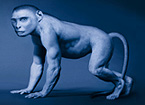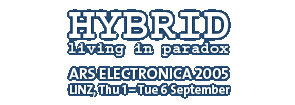| |
|
|
|
|
||
|
||||||||||||||||||||
 |
 |
||||||||||||||
| Back | |||||
Ars Electronica 2005
These are the four main areas on which the festival will focus in symposia and artists’ lectures, exhibitions and installations, concerts and performances, workshops and seminars, and artistic interventions in public spaces all around the city. Since 1979, Ars Electronica has been dedicated to the critical discussion of and reflection upon media culture. With its focal point situated at the intersection of art, technology and society, it is above all the endeavor to nurture up-close-and-personal encounters involving artists, designers, philosophers, sociologists, engineers and scientists from all over the world that endow the Festival with its very special character. Gerfried Stocker, Christine Schöpf (Directors Ars Electronica)
The hybrid is the signature of our age, emblematic of the casualness with which we have established ourselves in real, physical habitats as well as in digital, virtual domains, of the way that dealing with and reconfiguring cultural differences and antipodes has become a matter taken completely for granted, and of the disturbingly routine nature of the way we play with the building blocks of life. The cultural history of hybridization, from the husbandry and cross-breeding of plants and animals, the mechanical, electrical and digital simulation and replication of nature, and now to the arrogance of modern genetic engineering, has also always been an expression of humanity’s age-old longings to rise above itself and to modify and correct nature. And just as every organism mobilizes the forces of its immune system to fight off intruders and foreign bodies (even in the case of a life-saving organ transplant), every instance of cultural or social hybridization summons forth attitudes of resistance and defensive action: fundamentalist purism, efforts at exclusion resulting from the fear of assimilation, or a sense of skepticism that sees hidden behind these “new” forms of integration nothing but innovative elaborations of the same old divisive forces. Hybridization as a cultural process can be calculated and controlled only in the rarest of cases. Its productive powers are mostly the outcome of happenstance or even in some cases the conscious wish to achieve differentiation; they are often byproducts of subversive action. This is especially evident in the successful culture jamming found in youth culture and pop music, but applies equally to numerous applications of digital technology. After all, nobody planned SMS or the dynamic, potent emergence of citizen journalism in the form of blogging, RSS-feeds and podcasting. Their emergence is also a hybrid that was most certainly foretold by visionary artists and cultural theoreticians, though not by the marketing gurus of the New Economy. The first hybrid is the human. And living in paradox. A mix of mind and matter, a translating device, a handshake from mind to matter and vice-versa, humankind is in a permanent state of hybridization, consciously and unconsciously. We live in paradox, in a suspension of disbelief that will last until the dust settles and the contradictions between self and other, between nationalisms and globalism, between democracy and state control are resolved. And the contradictions between the power of media and that of the state. And the contradictions between science and the economy generating hybrids for all purposes with a clear bias towards profitability over service to humanity. And the contradictions … Art is the food of hybridity. It is translating and transporting the modes of one culture into another, lifting bits of both and mixing. Sampling is not just one of the techniques of the digital, it has become a way of life. And we have DJs of culture, albeit operating at longer-term rhythms. What can people do but sample in an environment where everything is always available? Derrick de Kerckhove |
|
||||
| © Ars Electronica Linz GmbH, info@aec.at | |||||